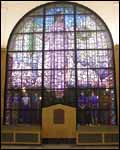Previous NPR reports on Grant Wood |
|
 |
Listen to a June 6, 1991, Morning Edition report on Iowa's celebration of the centennial of Grant Wood's birth. |
 |
Listen to a Feb. 13, 1976, All Things Considered interview with James Dennis, author of Grant Wood: A Study in American Art and Culture. |
 |
Nov. 18, 2002 --
In his home of Cedar Rapids, locals knew Grant Wood as the "town artist." A self-taught painter and devoted Iowan, Wood's early canvases, often meticulously rendered landscapes of fields of corn waving in the wind, showcased his love for his home state. But it's his most famous painting for which the majority of Americans will remember him. Need a hint? Here are four: a white house with a sloped roof, a sour-looking woman, a stern man... and a pitchfork.
This week on Present at the Creation, NPR's ongoing series on the origins of American icons, Melissa Gray looks at one of the most recognizable examples of American art, American Gothic. For Morning Edition, Gray tells the story behind Wood's masterpiece.
Wood's local renown helped land him several commissions, including the large stained-glass window at the Veterans Memorial Building in downtown Cedar Rapids. He had been to Europe before in search of inspiration and it was on his trip to Germany that provided a spark of illumination. He was in Munich, where the window was under construction, when he inspected Flemish paintings in a local museum. He appreciated the simplicity of those works and decided to apply the technique to subjects back home.
One experiment in this style is called Woman with Plant(s). It shows the direct influence of Wood's trip to Munich, says Terry Pitts, the director of the Cedar Rapids Museum of Art. "It's a portrait of his mother and it looks like a 16th- century High Renaissance or Northern Renaissance portrait of a famous person in their own landscape holding their attribute -- in her case, a plant." Encouraged by his effort, Wood began looking for more subjects.
Traveling the Iowa landscape in the summer of 1930, Wood happened upon a house in Eldon that caught his fancy. "He was riding around downtown and happened to spot this place," says Bruce Thiher, the town's postmaster and the proprietor of the American Gothic House, still standing today under the ownership of the state of Iowa. It was, says Thiher, "a modest-style house with a gothic-style window across the street from the stockyards, and he found the whole placement of the thing rather amusing. I've been told that the window came as a kit out of a Sears Roebuck catalogue."
Wood intended his title as a visual pun: that upstairs window, with its pointed arch, is of the Gothic architectural style, a reference that finds multiple counterpoints in figures standing in the foreground. The three-pronged pitchfork is one obvious example, but look more closely and you'll see echoes of the design on the face of the man, the bib of his overalls, and the lines on his shirt. In fact, the straightforward Gothic style extends to the directness of the painting itself.
It's like the aphorism about married couples gradually looking more and more like each other, or how people inevitably resemble their pets; the man and the woman seem to have grown into reflections of the simple, sharp lines of their residence.
The painting got Wood in some trouble with people who thought that he was poking fun at the provincial nature of small-town folk. In addition to its architectural connotations, "gothic" can also mean crude or underdeveloped. It's an implication Wood was likely aware of when he titled the painting, though it's unlikely that this was his sole observation about the pair.
"He always shied away from that claim... that he was satirizing the Midwest," says Mel Andringa, a Cedar Rapids artist. "Because he had to live here."
The artist avoided revealing any explicit meaning behind his work. His younger sister Nan served as a model for the woman, and Andringa believes Wood may have tried to maintain ambiguity for his sister's sake. Wood elongated Nan's face and neck to extend the visual metaphor -- and he had Dr. B.H. McKeeby, a local dentist, prop up the famous pitchfork. The real-life pair was separated by a significant age gap, something that's not so obvious in the painting. Are they husband and wife? Father and daughter? Something even more... complicated?
Andringa believes in a simpler explanation -- "He didn't want her to think she looked as old as his dentist!" -- but concedes "it gives a twist to the picture if you think of those jokes about the father's daughter, protecting her virginity with a pitchfork... and that gives another twist on 'gothic' as well."
Ambiguity has helped the painting endure. "I think what strikes you from the beginning is that you're with one of the most exciting couples in the history of art," says curator Daniel Schulman of the Art Institute of Chicago, where the painting hangs today. "They look dour and sour and four-square and geometric... you just never run out of this encyclopedia of detail."
In Depth
 Read about more American art icons profiled in the Present at the Creation series.
Read about more American art icons profiled in the Present at the Creation series.
Other Resources
• See American Gothic at the Art Institute of Chicago.
• See Woman with Plant(s) and some of Wood's other works at the Cedar Rapids Museum of Art.
• Explore Wood's works and inspirations at the University of Virginia's American Studies Program.
• Visit the American Gothic House in Eldon, Iowa.
This week on Present at the Creation, NPR's ongoing series on the origins of American icons, Melissa Gray looks at one of the most recognizable examples of American art, American Gothic. For Morning Edition, Gray tells the story behind Wood's masterpiece.
Wood's local renown helped land him several commissions, including the large stained-glass window at the Veterans Memorial Building in downtown Cedar Rapids. He had been to Europe before in search of inspiration and it was on his trip to Germany that provided a spark of illumination. He was in Munich, where the window was under construction, when he inspected Flemish paintings in a local museum. He appreciated the simplicity of those works and decided to apply the technique to subjects back home.
One experiment in this style is called Woman with Plant(s). It shows the direct influence of Wood's trip to Munich, says Terry Pitts, the director of the Cedar Rapids Museum of Art. "It's a portrait of his mother and it looks like a 16th- century High Renaissance or Northern Renaissance portrait of a famous person in their own landscape holding their attribute -- in her case, a plant." Encouraged by his effort, Wood began looking for more subjects.
Traveling the Iowa landscape in the summer of 1930, Wood happened upon a house in Eldon that caught his fancy. "He was riding around downtown and happened to spot this place," says Bruce Thiher, the town's postmaster and the proprietor of the American Gothic House, still standing today under the ownership of the state of Iowa. It was, says Thiher, "a modest-style house with a gothic-style window across the street from the stockyards, and he found the whole placement of the thing rather amusing. I've been told that the window came as a kit out of a Sears Roebuck catalogue."
Wood intended his title as a visual pun: that upstairs window, with its pointed arch, is of the Gothic architectural style, a reference that finds multiple counterpoints in figures standing in the foreground. The three-pronged pitchfork is one obvious example, but look more closely and you'll see echoes of the design on the face of the man, the bib of his overalls, and the lines on his shirt. In fact, the straightforward Gothic style extends to the directness of the painting itself.
It's like the aphorism about married couples gradually looking more and more like each other, or how people inevitably resemble their pets; the man and the woman seem to have grown into reflections of the simple, sharp lines of their residence.
The painting got Wood in some trouble with people who thought that he was poking fun at the provincial nature of small-town folk. In addition to its architectural connotations, "gothic" can also mean crude or underdeveloped. It's an implication Wood was likely aware of when he titled the painting, though it's unlikely that this was his sole observation about the pair.
"He always shied away from that claim... that he was satirizing the Midwest," says Mel Andringa, a Cedar Rapids artist. "Because he had to live here."
The artist avoided revealing any explicit meaning behind his work. His younger sister Nan served as a model for the woman, and Andringa believes Wood may have tried to maintain ambiguity for his sister's sake. Wood elongated Nan's face and neck to extend the visual metaphor -- and he had Dr. B.H. McKeeby, a local dentist, prop up the famous pitchfork. The real-life pair was separated by a significant age gap, something that's not so obvious in the painting. Are they husband and wife? Father and daughter? Something even more... complicated?
Andringa believes in a simpler explanation -- "He didn't want her to think she looked as old as his dentist!" -- but concedes "it gives a twist to the picture if you think of those jokes about the father's daughter, protecting her virginity with a pitchfork... and that gives another twist on 'gothic' as well."
Ambiguity has helped the painting endure. "I think what strikes you from the beginning is that you're with one of the most exciting couples in the history of art," says curator Daniel Schulman of the Art Institute of Chicago, where the painting hangs today. "They look dour and sour and four-square and geometric... you just never run out of this encyclopedia of detail."
In Depth
 Read about more American art icons profiled in the Present at the Creation series.
Read about more American art icons profiled in the Present at the Creation series.
Other Resources
• See American Gothic at the Art Institute of Chicago.
• See Woman with Plant(s) and some of Wood's other works at the Cedar Rapids Museum of Art.
• Explore Wood's works and inspirations at the University of Virginia's American Studies Program.
• Visit the American Gothic House in Eldon, Iowa.


Grant Wood's American Gothic, 1930.
Photo: Friends of American Art Collection, All rights reserved by The Art Institute of Chicago and VAGA, New York, NY, 1930.934. digital file © The Art Institute of Chicago. All Rights Reserved.
View enlargement.

Seen in this 1942 photo, Nan Wood Graham, Grant Wood's sister, and Dr. B.H. McKeeby, the family dentist, served as the models for American Gothic.
Photo: Cedar Rapids Museum of Art archives
View enlargement.

Grant Wood, right, and fellow artist John Steuart Curry in Stone City, Iowa, in the summer of 1933.
Photo: John W. Barry (1905-1988), Cedar Rapids Museum of Art archives
View enlargement.

Stained glass by Grant Wood at the Veterans Memorial Building in Cedar Rapids, Iowa.
Photo: Melissa Gray, NPR News
View enlargement.

Grant Wood's Woman with Plant(s), 1929.
Photo: Collection of the Cedar Rapids Museum of Art, Art Association Purchase
View enlargement.

Bruce Thiher is the current tenant of the house in Eldon, Iowa, that served as the backdrop of American Gothic.
Photo: Melissa Gray, NPR News
View enlargement.
